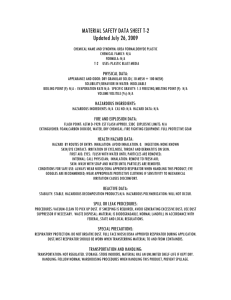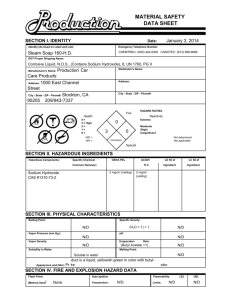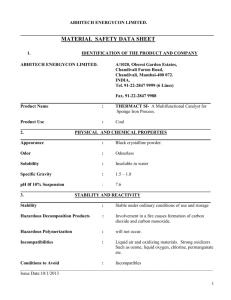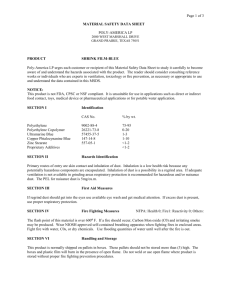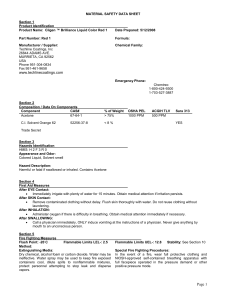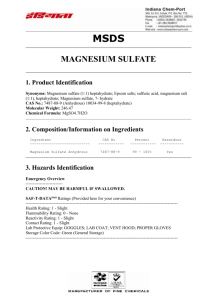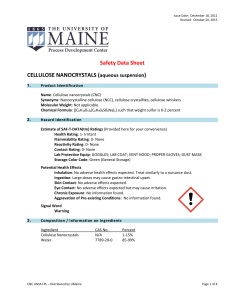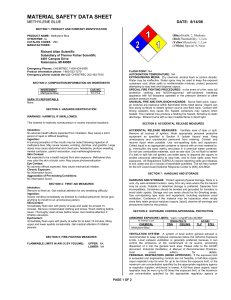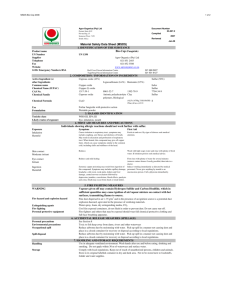barium sulfate - IndianaChem-Port
advertisement
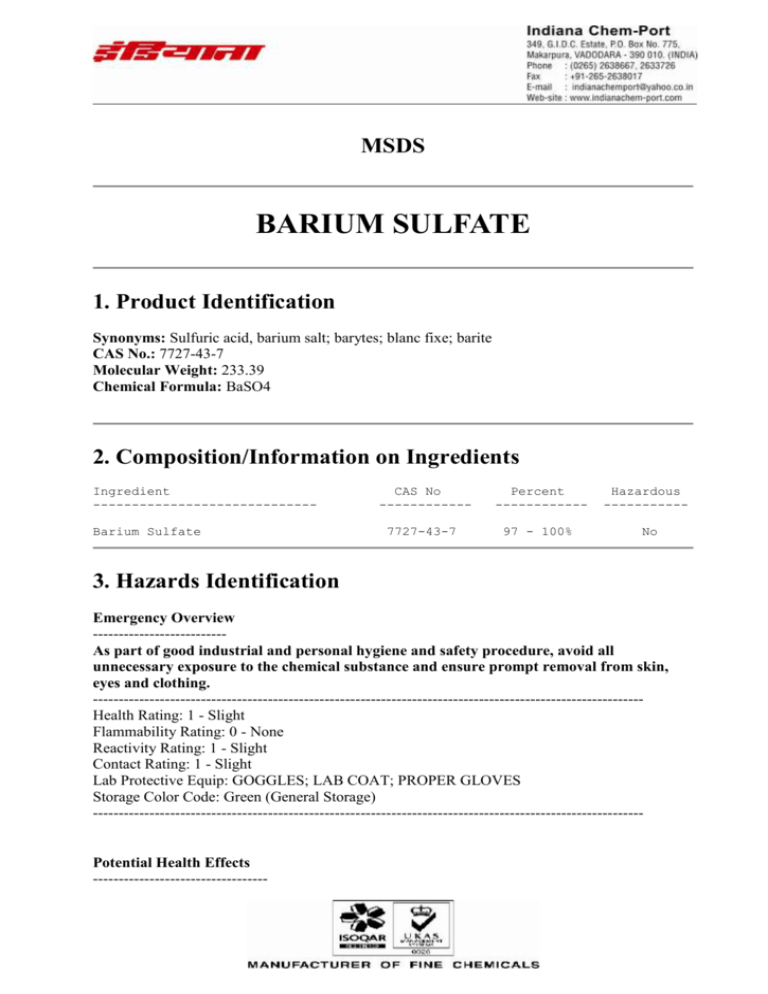
MSDS BARIUM SULFATE 1. Product Identification Synonyms: Sulfuric acid, barium salt; barytes; blanc fixe; barite CAS No.: 7727-43-7 Molecular Weight: 233.39 Chemical Formula: BaSO4 2. Composition/Information on Ingredients Ingredient ----------------------------Barium Sulfate CAS No -----------7727-43-7 Percent -----------97 - 100% Hazardous ----------No 3. Hazards Identification Emergency Overview -------------------------As part of good industrial and personal hygiene and safety procedure, avoid all unnecessary exposure to the chemical substance and ensure prompt removal from skin, eyes and clothing. ----------------------------------------------------------------------------------------------------------Health Rating: 1 - Slight Flammability Rating: 0 - None Reactivity Rating: 1 - Slight Contact Rating: 1 - Slight Lab Protective Equip: GOGGLES; LAB COAT; PROPER GLOVES Storage Color Code: Green (General Storage) ----------------------------------------------------------------------------------------------------------- Potential Health Effects ---------------------------------- Inhalation: Not expected to be a health hazard. Ingestion: Not expected to be a health hazard. Skin Contact: No adverse effects expected. Eye Contact: No adverse effects expected but dust may cause mechanical irritation. Chronic Exposure: Long term inhalation of dust may lead to deposition in lungs in sufficient quantities to produce baritosis - a benign pneumoconiosis. This produces a radiological picture even though symptoms and abnormal signs may not be present. Aggravation of Pre-existing Conditions: No information found. 4. First Aid Measures Inhalation: Remove to fresh air. Get medical attention for any breathing difficulty. Ingestion: Give several glasses of water to drink to dilute. If large amounts were swallowed, get medical advice. Skin Contact: Wash exposed area with soap and water. Get medical advice if irritation develops. Eye Contact: Wash thoroughly with running water. Get medical advice if irritation develops. 5. Fire Fighting Measures Fire: Not considered to be a fire hazard. Explosion: Not considered to be an explosion hazard. Fire Extinguishing Media: Use any means suitable for extinguishing surrounding fire. Special Information: In the event of a fire, wear full protective clothing and NIOSH-approved self-contained breathing apparatus with full facepiece operated in the pressure demand or other positive pressure mode. 6. Accidental Release Measures Ventilate area of leak or spill. Wear appropriate personal protective equipment as specified in Section 8. Spills: Sweep up and containerize for reclamation or disposal. Vacuuming or wet sweeping may be used to avoid dust dispersal. 7. Handling and Storage Keep in a tightly closed container. Protect from physical damage. Store in a cool, dry, ventilated area away from sources of heat, moisture and incompatibilities. Containers of this material may be hazardous when empty since they retain product residues (dust, solids); observe all warnings and precautions listed for the product. 8. Exposure Controls/Personal Protection Airborne Exposure Limits: -OSHA Permissible Exposure Limit (PEL): 15 mg/m3 total dust, 5 mg/m3 respirable dust -ACGIH Threshold Limit Value (TLV): 10 mg/m3 (TWA) Ventilation System: In general, dilution ventilation is a satisfactory health hazard control for this substance. However, if conditions of use create discomfort to the worker, a local exhaust system should be considered. Personal Respirators (NIOSH Approved): If the exposure limit is exceeded and engineering controls are not feasible, a half facepiece particulate respirator (NIOSH type N95 or better filters) may be worn for up to ten times the exposure limit or the maximum use concentration specified by the appropriate regulatory agency or respirator supplier, whichever is lowest.. A full-face piece particulate respirator (NIOSH type N100 filters) may be worn up to 50 times the exposure limit, or the maximum use concentration specified by the appropriate regulatory agency, or respirator supplier, whichever is lowest. If oil particles (e.g. lubricants, cutting fluids, glycerine, etc.) are present, use a NIOSH type R or P filter. For emergencies or instances where the exposure levels are not known, use a fullfacepiece positive-pressure, air-supplied respirator. WARNING: Air-purifying respirators do not protect workers in oxygen-deficient atmospheres. Skin Protection: Wear protective gloves and clean body-covering clothing. Eye Protection: Use chemical safety goggles. Maintain eye wash fountain and quick-drench facilities in work area. 9. Physical and Chemical Properties Appearance: Fine, white powder. Odor: Odorless. Solubility: Insoluble in water. Specific Gravity: 4.5 @ 15 (59F) pH: 5% in water is neutral to litmus. % Volatiles by volume @ 21C (70F): 0 Boiling Point: 1600C (2912F) Decomposes. Melting Point: 1580C (2876F) Vapor Density (Air=1): No information found. Vapor Pressure (mm Hg): No information found. Evaporation Rate (BuAc=1): No information found. 10. Stability and Reactivity Stability: Stable under ordinary conditions of use and storage. Hazardous Decomposition Products: Burning may produce sulfur oxides. Hazardous Polymerization: Will not occur. Incompatibilities: Aluminum, phosphorus. Conditions to Avoid: Dusting and incompatibles. 11. Toxicological Information No LD50/LC50 information found relating to normal routes of occupational exposure. --------\Cancer Lists\--------------------------------------------------------NTP Carcinogen--Ingredient Known Anticipated IARC Category -------------------------------------------------------------Barium Sulfate (7727-43-7) No No None 12. Ecological Information Environmental Fate: This material may bioaccumulate to some extent. Environmental Toxicity: No information found. 13. Disposal Considerations Whatever cannot be saved for recovery or recycling should be managed in an appropriate and approved waste facility. Although not a listed RCRA hazardous waste, this material may exhibit one or more characteristics of a hazardous waste and require appropriate analysis to determine specific disposal requirements. Processing, use or contamination of this product may change the waste management options. State and local disposal regulations may differ from federal disposal regulations. Dispose of container and unused contents in accordance with federal, state and local requirements. 14. Transport Information Not regulated. 15. Regulatory Information Not regulated. 16. Other Information NFPA Ratings: Health: 0 Flammability: 0 Reactivity: 0 Label Hazard Warning: As part of good industrial and personal hygiene and safety procedure, avoid all unnecessary exposure to the chemical substance and ensure prompt removal from skin, eyes and clothing. Label Precautions: None. Label First Aid: Not applicable. Product Use: Laboratory Reagent. Revision Information: MSDS Section(s) changed since last revision of document include: 3, 8. Disclaimer: ***************************************************************************** INDIANA CHEM-PORT, provides the information contained herein in good faith but makes no representation as to its comprehensiveness or accuracy. This document is intended only as a guide to the appropriate precautionary handling of the material by a properly trained person using this product. Individuals receiving the information must exercise their independent judgment in determining its appropriateness for a particular purpose. *****************************************************************************
